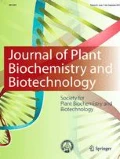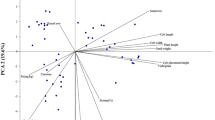Abstract
The North-Eastern Himalayan (NEH) region of India is endowed with rich maize genetic resources which is important from both genetics and evolutionary viewpoints. Mimban landrace of maize is a popular choice in Mizoram as food among the locals due to its stickiness caused by recessive wx1 gene resulting in high amylopectin in the grains. In the present study, a set of 24 Mimban accessions possessing high amylopectin (mean 89.72%, range 80.2–93.7%) content were analyzed. 93 SSRs markers generated a total of 334 alleles with a range of 2–9 and mean of 3.59 alleles per locus. Polymorphism information content varied from 0.117 to 0.829 with an average of 0.528. A total of 20 unique and 24 rare alleles were detected. Twenty-seven major alleles with individual frequencies exceeding 0.70 were also identified across the accessions. Cluster analyses classified 24 genotypes into three major clusters each having 2, 14 and 9 accessions. The clustering pattern was largely congruent with the geographical information. Diverse origin of the accessions was also depicted by the SSR based principal coordinate analysis. These accessions with high amylopectin content from diverse clusters may be crossed to derive heterotic hybrid and also might be used for novel gene identification. Thus information generated here possesses great potential in their utilization in the waxy corn genomics and breeding and emphasizes the need for further exploration of unique trait specific genepool from unexplored areas. This is the first report of molecular characterization of Mimban landrace accessions from NEH region.





Similar content being viewed by others
Abbreviations
- PIC:
-
Polymorphism information content
- NEH:
-
North-Eastern Himalayan
- GIS:
-
Geographic information system
- PCoA:
-
Principal coordinate analysis
- CTAB:
-
Cetyl trimethylammonium bromide
- EDTA:
-
Ethylenediaminetetraacetic acid
- PCR:
-
Polymerase chain reaction
- SSR:
-
Simple sequence repeats
References
Baltazar BM, Castro Espinoza L, Espinoza Banda A, de la Fuente Martínez JM, Garzón Tiznado JA et al (2015) Pollen-Mediated gene flow in maize: implications for isolation requirements and coexistence in Mexico, the center of origin of maize. PLoS ONE. 10(7):e0131549. https://doi.org/10.1371/journal.pone.0131549
Cao W, Hucl P, Scoles G, Chibbar RN (1998) Genetic diversity within spelta and macha wheats based on RAPD analysis. Euphytica 104:181–189
Chibuike CS, Okporie EO, Ekwu LG, Onyishi GC, Andrew CN (2015) Maize genotypes collection and characterization from local government areas in Ebonyi state, Nigeria. J Plant Breed Genet 03(01):17–23
Dean RE, Dahlberg JA, Hopkins MS, Mitchell SE, Kresovich S (1999) Genetic redundancy and diversity among ‘Orange’ accession in the U.S. National sorghum collection as assessed with simple sequence repeats (SSR) markers. Crop Sci 39:1215–1221
Devi EL, Hossain F, Muthusamy V, Chhabra R, Zunjare RU, Baveja A, Kumar S, Goswami JR, Dosad S (2017) Microsatellite marker-based characterization of waxy maize inbreeds for their utilization in hybrid breeding. Biotech 7:316. https://doi.org/10.1007/s13205-017-0946-8
Dubreuil P, Rebourg C, Merlino M, Charcosset A (1999) Evaluation of a DNA pooled-sampling strategy for estimating the RFLP diversity of maize populations. Plant Mol Biol Report 17:123–138
Dubreuil P, Warburton M, Chastanet M, Hoisington D, Charcosset A (2006) More on the introduction of temperate maize into Europe: large-scale bulk SSR genotyping and new historical elements. Maydica 51:281–291
Engels JMM, Visser L (2003) A guide to effective management of germplasm collections. IPGRI handbook for genebanks No. 6. International Plant Genetic Resources Institute, Rome, Italy
Goldstein DB, Pollock DD (1997) Launching microsatellites: a review of mutation processes and methods of phylogenetic inference. J Hered 88:335–342
Hamblin MT, Warburton ML, Buckler ES (2007) Empirical comparison of simple sequence repeats and single nucleotide polymorphisms in assessment of maize diversity and relatedness. PLoS ONE 2(12):e1367. https://doi.org/10.1371/journal.pone.0001367
Hao D, Zhang Z, Cheng Y, Chen G, Lu H, Mao Y, Shi M, Huang X, Zhou G, Xue L (2015) Identification of genetic differentiation between waxy and common maize by SNP genotyping. PLoS ONE 10:e0142585
Hossain F, Muthusamy V, Bhat JS, Jha SK, Zunjare R, Das A, Sarika K, Kumar R (2016) Maize: utilization of genetic resources in maize improvement. In: Broadening the genetic base of grain cereals. Springer. https://doi.org/10.1007/978-81-322-3613-9_4
Hossain F, Muthusamy V, Pandey N, Vishwakarma AK, Baveja A, Zunjare R, Thirunavukkarasu N, Saha S, Manjaiah KM, Prasanna BM, Gupta HS (2018) Marker-assisted introgression of opaque2 allele for rapid conversion of elite hybrids into quality protein maize. J Genet. https://doi.org/10.1007/s12041-018-0914-z
Hung TN, Huyen TN, Loc NV, Cuong BM (2012) The application of SSR molecular indicator to assess the purity and genetic diversity of waxy corn inbred lines. J ISSASS 18:45–54
Jugenheimer RW (1992) Corn in “The Software Tool works Multimedia Encyclopedia”, version 1.5, Grolier, Inc
Karen VPH, Karla P, Elthon VA, Jeanett CH, Pedro SANA, Jose AG, Misael OV, Jose ALPV (2013) Microsatellite-based genetic diversity among accessions of maize landraces from Sinaloa in México. Hereditas 150:53–59
Kumari J, Gadag RN, Prasanna BM (2005) Molecular profiling of maize (Zea mays L.) inbred lines using SSR markers. Indian J Genet 65:249–252
Kumari J, Kumar A, Singh TP, Bhatt KC, Mishra AK, Semwal DP, Sharma RK, Rana JC (2017) Collection, evaluation and phenotypic diversity assessment of maize germplasm from North Eastern Himalayan region. Indian J Agric Sci 87(6):727–733
Levinson G, Gutman GA (1987) Slipped strand misparing: a major mechanism for DNA sequence evolution. Mol Biol Evol 4:203–221
Liet VV, Thinh TT (2009) Genetic diversity of local maize (Zea mays L.) accessions collected in highland areas of Vietnam revealed by RAPD markers. J Sci Dev 7:192–201
Murray MG, Thompson WF (1980) Rapid isolation of high molecular weight plant DNA. Nucleic Acids Res 8(19):4321–4325
Park JS, Park JY, Park KJ, Lee JK (2008) Genetic diversity among waxy corn accessions in Korea revealed by microsatellite markers. Korean J Breed Sci 40:250–257
Perrier X, Flori A, Bonnot F (2003) Data analysis methods. In: Hamon P, Seguin M, Perrier X, Glaszmann JC (eds) Genetic diversity of cultivated tropical plants. Science Publishers Mont-pellier, Enfield, pp 43–76
Prasanna BM, Hoisington D (2003) Molecular breeding for maize improvement: an overview. Indian J Biotechnol 2:85–98
Prasanna BM, Sharma L (2005) The landraces of maize (Zea mays L.) diversity and utility. Indian J Plant Genet Resour 18:155–168
Rebourg C, Dubreuil P, Charcosset A (1999) Genetic diversity among maize populations: bulk RFLP analysis of 65 accessions. Maydica 44:237–249
Rebourg C, Gousnard B, Charosset A (2001) Large scale molecular analysis of tradition European maize population: relationship with morphological variation. Heredity 86:574–587
Rebourg C, Gouesnard B, Welcker C, Dubreuil P, Chastanet M, Charcosset A (2003) Maize introduction into Europe: the history reviewed in the light of molecular data. Theor Appl Genet 106:895–903
Reyes-Valdes MH, Burgueno J, Singh S, Martınez O, Sansaloni CP (2018) An informational view of accession rarity and allele specificity in germplasm banks for management and conservation. PLoS ONE 13(2):e0193346. https://doi.org/10.1371/journal.pone.0193346
Sa KJ, Park JY, Choi SH, Kim BW, Park KJ, Lee JK (2015) Genetic diversity, population structure, and association mapping of agronomic traits in waxy and normal maize inbred lines. Genet Mol Res 14:7502–7518
Sa KJ, Hong TK, Lee JK (2018) Genetic diversity and association analyses of canadian maize inbred lines with agronomic traits and simple sequence repeat markers. Plant Breed Biotechnol 6(2):159–169
Semagn K, Magorokosho C, Vivek BS, Makumbi D, Beyene Y, Mugo S, Prasanna BM, Warburton ML (2012) Molecular characterization of diverse CIMMYT maize inbred lines from eastern and southern Africa using single nucleotide polymorphic markers. BMC Genom 13:113. https://doi.org/10.1186/1471-2164-13-113
Senior ML, Murphy JP, Goodman MM, Stuber CW (1998) Utility of SSRs for determining genetic similarities and relationships in maize using an agarose gel system. Crop Sci 38:1088–1098
Sharma L, Prasanna BM, Ramesh B (2010) Analysis of phenotypic and microsatellite-based diversity of maize landraces in India, especially from the North East Himalayan region. Genetica 138:619–631
Shiferaw B, Prasanna BM, Hellin J, Banziger M (2011) Crops that feed the world, 6. Past successes and future challenges to the role played by maize in global food security. Food Secur 3:307–327
Singh AR, Singh SB, Dutta SK, Boopathi T, Lungmuana, Saha S, Devi MT, Singh NH (2016) Multi cob-bearing popcorn (Puakzo) maize: a unique landrace of Mizoram, North East, India. Curr Sci 110:1392
Singode A, Sekhar JC, Srinivasan K, Prasanna BM (2009) Evaluation of yield performance of selected North East Himalayan (NEH) maize landrace accessions of India, outside their habitat. Indian J Genet 69(3):191–198
Tian M, Tan G, Liu Y, Rong T, Huang Y (2009) Origin and evolution of Chinese waxy maize: evidence from the Globulin-1 gene. Genet Resour Crop Evol 56(2):247–255
van Hintum TJL, Visser DL (1995) Duplication within and between germplasm collections II. Duplication in four European barley collections. Genet Resour Crop Evol 42:135. https://doi.org/10.1007/BF02539517
Warburton ML, Xianchun X, Franco J, Melchinger AE, Frisch M, Bohn M, Hoisignton D (2002) Genetic characterization of CIMMYT inbred maize lines and open pollinated using large scale fingerprinting methods. Crop Sci 42:1832–1840
Watson SA (1988) Marketing, processing, and utilization. In: Sprague GF, Dudley JW (eds) Corn and corn improvement. Agronomy monograph no. 18. American Society of Agronomy, Madison, pp 881–934
Xu SX, Liu J, Liu GS (2004) The use of SSRs for predicting the hybrid yield and yield heterosis in 15 key inbred lines of Chinese maize. Hereditas 141:207–215
Yu RH, Wang YL, Sun Y, Liu B (2012) Analysis of genetic distance by SSR in waxy maize. Genet Mol Res 11(1):254–260
Yun SH, Matheson NK (1990) Estimation of amylose content of starches after precipitation of amylopectin by Concanavalin-A. Starch/Starke 42:302–305
Zheng H, Wang H, Yang H, Wu J, Shi B, Cai R, Xu Y, Wu A, Luo L (2013) Genetic diversity and molecular evolution of Chinese waxy maize germplasm. PLoS ONE 8:1–11
Acknowledgements
First author thanks Indian Council of Agricultural Research for providing the Junior Research Fellowship during the Master’s programme. The help and support received from ICAR–National Bureau of Plant Genetic Resources, New Delhi and ICAR-Indian Agricultural Research Institute, New Delhi are duly acknowledged. We also thank Dr. Rajkumar Zunjare for his help during the study.
Author information
Authors and Affiliations
Corresponding author
Ethics declarations
Conflict of interest
All authors declare that they have no conflict of interest.
Additional information
Publisher's Note
Springer Nature remains neutral with regard to jurisdictional claims in published maps and institutional affiliations.
Electronic supplementary material
Below is the link to the electronic supplementary material.
Rights and permissions
About this article
Cite this article
Rathod, N.K.K., Kumari, J., Hossain, F. et al. Characterization of Mimban maize landrace from North-Eastern Himalayan region using microsatellite markers. J. Plant Biochem. Biotechnol. 29, 323–335 (2020). https://doi.org/10.1007/s13562-019-00524-0
Received:
Accepted:
Published:
Issue Date:
DOI: https://doi.org/10.1007/s13562-019-00524-0




